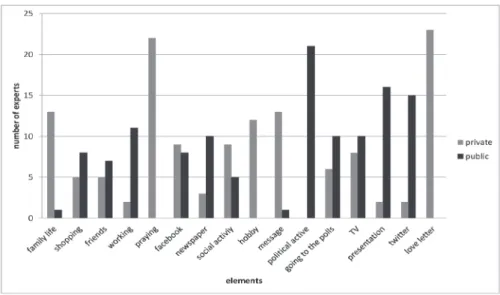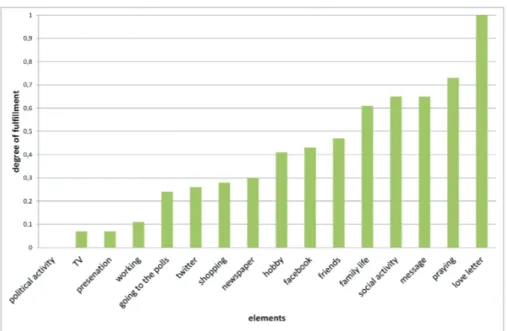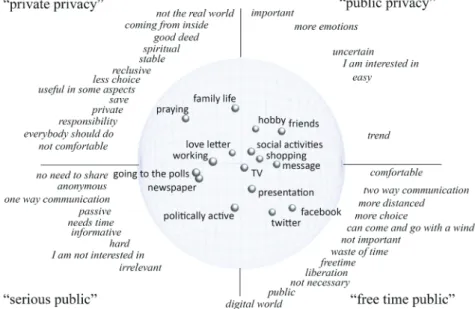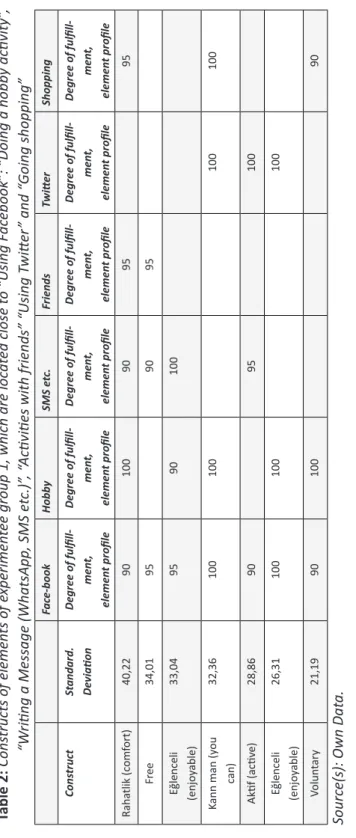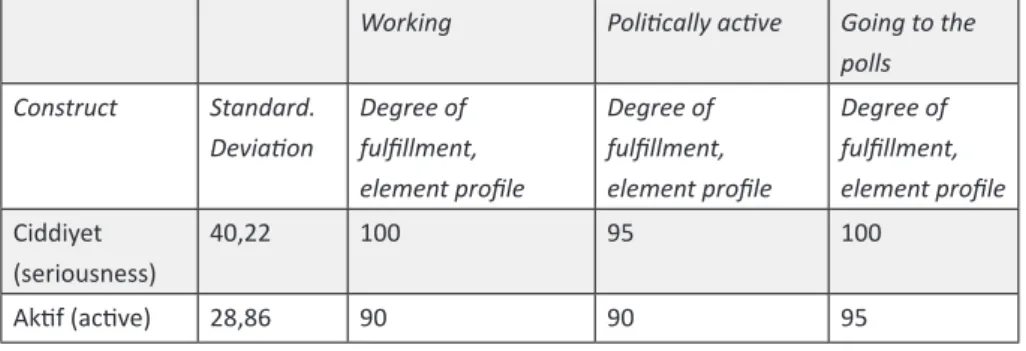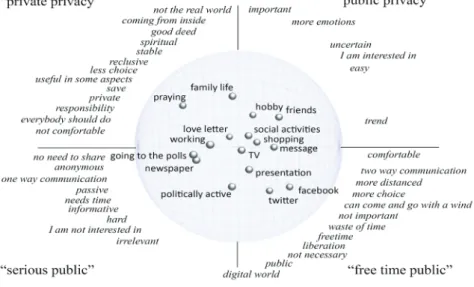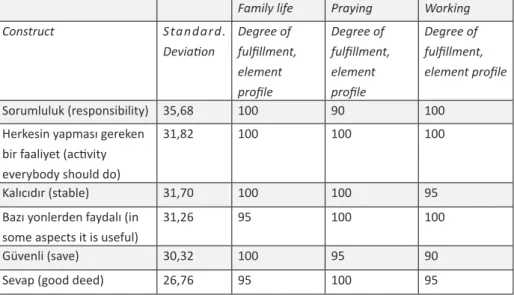The Relevance Patterns of Public and Privacy for Digital
Natives in Turkey
LUTZ PESCHKE
AbstractThe wide-spread and increasing communication via social media causes an entanglement be-tween publicity and privacy. According to the meta-process of today’s mediatized communica-tion as described by Krotz, the user-generated content is established as an important channel of social communication today. In this way, a change is currently taking place regarding the question, which personal information should be made publicly available. The outcome of this is a necessity to understand, whether the mediatized communication has an effect on the boundaries between privacy and public.
With help of a scientific study with academic participants in Turkey based on George Kelly’s personal construct psychology, two groups with different understandings of privacy could be identified. In the constructed world of one group, the digital whoness, as derived from Kant’s question of whoness by Capurro et al., is located in the public space. This is an indication that the boundaries between privacy and public are blurred and the relevance patterns of privacy and public are to be thought in new categories, since privacy becomes more and more a me-diatized privacy.
Keywords: privacy; public; digital whoness; social media; repertory grid Technique;
con-structed world; personal construct psychology.
Bilkent University, Faculty of Fine Arts, Design and Architecture, Ankara, Turkey Makale Geliş Tarihi : 17.05.2016
Türkiye’deki Dijital Yerliler İçin Kamuya Açık Yaşam Alanı
ve Özel Hayatın Gizliliği Kalıplarının Önemi
LUTZ PESCHKE
ÖzSosyal medya ile artarak yargınlaşan ve gelişen iletişim, kişinin özel hayatı ile kamuya açık alanı arasında karmaşıklığa neden olmaktadır. Krotz tarafından açıklandığı gibi bugün, medya içinde yapılandırılan iletişim uygulamalarında, kullanıcı tarafından oluşturulan içerik, önemli bir sosy-al iletişim kansosy-alı üzerine kurulmuştur. Bu şekilde, günümüzde, ne tür kişisel bilgilerin kamuya açılması gerektiği konusunda bir değişim olmuştur. Bunun bir sonucu olarak, medya üzerine kurulmuş bu iletişim şeklinin, özel alan ile kamuya açık alan arasındaki sınıra bir etkisi olup olmadığını anlamak gerekmektedir.
Türkiye’deki akademik katılımcılarla birlikte bir bilimsel çalışma yapılmış ve George Kelly’nin “personal construct psychology” teorisine dayanarak, özel hayatın gizliliği (mahremiyet ilkesi), farklı anlayışlara sahip iki ayrı grup üzerinde incelenmiştir.
“Constructivism” teorisi çerçevesinde, bir grubun yapılandırılmış dünyasında (construct-ed world) Capurro tarafından, Kant’ın kimlik (whoness) sorusundan türetilen, dijital kimlik, kamuya açık alanda yer almaktadır. Kamuya açık alan ile özel alan arasındaki sınır keskin hatlar-la belirlenemez, başka bir ifade ile, bu sınır buhatlar-lanıktır. Özel hayatın artık daha fazhatlar-la medya üze-rine temellendirilmiş olması nedeniyle, bu durum kişinin özel hayatı ile kamuya açık alanının yeni kategorilerde düşünülebilir olduğunun bir göstergesidir.
Anahtar Kelimeler: Özel hayatın gizliliği, mahremiyet, kamusal alan, dijital kimlik, sosyal
medya
The Relevance Patterns of Public and Privacy for Digital Natives in Turkey 1. Introduction
The term “privacy“ is basically defined as a confined space belonging to an indi-vidual which is only accessible for a self-determined group of people. The acces-sibility of the private space is either one of the most critical and most important characteristics of privacy. On the one hand, “privacy” only exists in the distin-ction of “public”. I don’t want to share every detail of my life with everyone. I want to have a private domain where I can think and act freely without any bad consequences and the duty of apologies. Outside of this private domain there is the public space, where I have to obey rules and where the others have the right to interact with me without asking for permission (Güneş Peschke, 2014: 71). The right to define the private and the public space belongs to the individual. On the other hand, for the formation of the own Self there is a need of permeability between “privacy” and “public”. Privacy is never a space which is shared with no-body. In fact giving and getting information about the privacy of other individual is an important requirement in the process of self-determination. An individual who does not have information about or from other individuals cannot determi-ne who or what he/she is (Brosette, 1991: 25)
This understanding of privacy corresponds with the model of the everyday life world of Schütz and Luckmann. According to them the everyday life world is not a private but an intersubjective and therefore social reality. This has impor-tant consequences for the constitution and structure of subjective reservoirs of knowledge. The individual is born into a historical social world. Hence his/her biographical situation is a priori limited and predetermined by specific social con-ditions (Schütz and Luckmann, 2003: 311). Reflecting on both, Brosette’s as well as Schütz and Luckmann’s concepts shows that privacy can only exist by sharing it with a group of other select individuals, because only the matching of the infor-mation of the other’s private life with his/her own reservoir of knowledge leads to an understanding of his/her self and the distinction of privacy and public.
In the context of privacy the decision of revealing and concealing less or more intimate details of personal life plays an important role. The question about what to reveal to, and what to conceal from, the public defines the space of in-dividual privacy.
This leads to Kant’s question of “whoness”: Who are we humans? He consi-ders, that the human cannot only be regarded as a “whatness”, which belongs to a physical, phenomenal world, but with an additional “noumenal” nature, whi-ch is free and autonomous (Capurro et al., 2013: 59; Kant, 1974). Eldred stated that Kant’s thinking is dual. With regard to natural laws, we are heteronomous and our heteronomy is unavoidable. But on the other side, we are free and
au-tonomous to follow or refuse the moral call. But Kant does not mean that this individual thinking and acting takes place in isolation. Instead, it is inseparable from the freedom to communicate by using various media. Besides respecting the individual’s freedom to communicate, Kant attaches great importance to the freedom to use media for communication. The freedom of thoughts is closely related to the freedom to communicate the thoughts to others and to receive thoughts from others. Consequently there is no freedom of thinking without the freedom of using media to communicate (ibid., 59-62). But when we consider this aspect for the definition of privacy, there should be a change of privacy cau-sed by the turn to today’s media bacau-sed communication.
Since the implementation of the social media, online media has become a central part in our communication. Krotz claims that in the course of social development communication changes increasingly because of more and more newly appearing media. But this does not mean that the media are the active part in this development. Rather, the human beings and their behavior in using media are responsible for the change of communication. (Krotz, 2001: 19). For understanding the change of everyday life, social relations, cultures and socie-ties as caused and influenced by the media, he conceptualized and examined a meta process: “mediatization”. According to Krotz, there is an increasing medial dissolution regarding time, space and social systems. Media are not used step by step in a chronological way any longer, as when I first use my telephone to call my friend and then watch TV. The media are rather used simultaneously. It is possible to call a relative via mobile, while watching TV, communicating with a friend in a foreign country via Skype and chatting with “friends” and “followers” via Facebook and Twitter seemingly at the same time. (Güneş Peschke and Pes-chke, 2013: 858). Furthermore, media are available at many more places like TVs in bars, wireless internet in airports etc. as additional virtual spaces and they are used in new contexts (Krotz, 2001: 22).
The central character of social media is the active user, who mutates to a “prosumer” due to the participatory possibilities. Simultaneously he is producer, consumer and program manager in the web. The user-generated content is es-tablished as an important channel of social communication today. With help of commenting, drafting one’s own article, rating, and uploading of media files such as images and videos, the user can intervene in the digital world and take a pub-lic position. This induces a change in the question, which personal information should be made publicly available (Thimm, 2004). But the high level of participa-tion does not change only the net itself, but also the attitude and behavior of the user: they take advantages of their potential influence to organize themselves collectively as individuals and their interests as well as their knowledge in the virtual space in multiple ways (Peschke and Schröder 2011).
The computer generated communication does not occur only with real na-mes and identities of the real world. Usually the users create nicknana-mes. These nicknames fulfill two functions of a mask: on the one hand they protect users from others by hiding their identity of the real world. On the other hand, de-pending on the chosen nickname, it attracts the interest of the other users and the access to the communication network will be facilitated (Ackermann, 2011). Thus, users create various partial identities, e.g. professional, gender or fan iden-tities. These partial identities generate an identity patchwork of the individual (Konert and Hermanns, 2002). This digital whoness can differ completely from the real world whoness. Associated with the aspect of digital whoness is the qu-estion about the relation between the real and digital privacy.
One central aspect of the digital privacy is the informational self-determina-tion. The digital network offers search engines and data memories with an incre-asing abundance of pictures, movies and written texts. The shift of privacy to a digital privacy as stated above brings up the question of how to protect the priva-cy in the virtual world of the internet. Since the beginning of the digital age, the balance between forgetting and remembering has changed (Mayer-Schönberger, 2009). Before the penetration of digital media into the everyday life, forgetting was the norm and remembering the exception. Thus, the power of society be-longed to the interest to not be forgotten. Today, in times of search engines and data storage, there is a shift in the balance between remembering and forgetting. The hitherto existing principle “the web never forgets!” has to give way to the demand to be forgotten. (Nolte, 2011; Peschke, 2015). Baek et al. analyzed in social softwares two different conventional frames according to their ability to support the protection of user’s informational privacy. They found out, that the so-called opt-in frame, where the users consciously have to accept the risk of pri-vacy infringement, protects the user’s informational pripri-vacy better than opt-out frame, where users have actively to decline consent if they wish to protect their privacy (Baek et al., 2014).
But adjusting the regulations for the protection of privacy requires the un-derstanding of the relevance patterns of public and privacy of the society. Kwon et al. recently started a study to identify the motivational factors for using social network services like Facebook and Twitter. They identified that perceived mo-bility, usefulness and connectiveness play a significant role in the decision to use Facebook or Twitter (Kwon et al., 2014). This motivated the research questions of this study:
RQ1: Where are Facebook and Twitter localized in the semantic space of privacy and public of the user’s life world?
RQ2: Is the treatment of media usage able to give information about the relevance pattern of the privacy of digital natives?
According to the concepts of Brosette as well as Schütz and Luckmann, pri-vacy is not an impermeable space, but it depends on the decision what to reve-al and what to concereve-al. Based on Krotz’ metaprocess of the mediatized world, the penetration of social media in our everyday communication leads to the fol-lowing hypothesis:
H1: The penetration of social media in our everyday’s communication and its potential to create different patchwork identities changes the relation of reve-aling and concereve-aling of the individual’s own personal data.
H2: The digital whoness with its digital privacy is part of the public space of the real world. This leads to a blurring of public and privacy.
H3: The mediatized world changes the relevance pattern of privacy.
Thus, a study was performed where media behavior assessment of Turkish digital natives were analyzed. The study is based on the model of constructi-vist alternativism. According to it, the reality of a subjective world, including of the individual understanding of privacy and public is grounded on the process of distinction and the development of alternative constructions. The constructed world based on distinctions yields a semantic space, which indicates the public and private domain of the individuals. Therefore, the repertory grid techniques grounded on Kelly’s personal construct psychology is a useful theory. In the fol-lowing chapter this qualitative interview technique will be explained.
2. Methods
2.1. Repertory Grid Technique
For the interviews the so called Repertory Grid Technique was applied. Repertory grid is an interview technique based on “personal construct psychology”, which was devised by the American psychologist George A Kelly in 1955 (Kelly, 1955). For a long time Kelly’s theory was neglected or forgotten. From time to time, in the German-speaking environment personal construct psychology was discussed as an insider tip. But in recent years, in the English-speaking scientific world this theory and the corresponding interview techniques have become more popular. According to Scheer and Catina it can be accounted for by the cognitive turn, which captured wide ranges of the behavioral science (Scheer and Catina, 1993).
Kelly’s theory of personal constructs is based on the constructivist approa-ch, that the world can only be recognized by an individual, when the world is eva-luated and interpreted by him/her and interrelated with his/her own subjective world. Thus, the reality is not an absolute truth, but it is grounded on alternative interpretations, which can be chosen (Bonarius et al., 1981). The evaluations can differ between different human beings. Facts which arise out of these evaluati-ons can be items of alternative cevaluati-onstruction. Hence, these philosophical positi-ons are also called cpositi-onstructivist alternativism (Catina and Schmitt, 1993: 12).
Kelly calls these psychological components, which a human being uses du-ring his process of construction, constructs. According to Bannister and Fransella (1981) constructs are basically distinctions. Results of reality are first distingu-ished by each other and afterwards clustered according to their similarities. In further steps the distinction becomes an abstraction. It means that the distinc-tion becomes independent of the events, which were originally responsible for the distinction. This abstraction of distinction makes it possible to predict the probability of other similar appearances among future events. Under this condi-tion a construct is chiefly a hypothesis about the existence of a certain class of objects, which can be similar or different under certain aspects. Kelly calls these objects elements. As a consequence, there are other elements as well, which can be assigned to constructs in the same way (Catina and Schmitt, 1993: 14).
According to Kelly, dichotomy plays a central part in the repertory grid the-ory. From his psychological point of view there are only dichotomic systems of thought. Similarities can only be perceived by human beings, when there are elements at the same time, which can be assigned to the opposite construct. The reality is neither an appearance only with similar elements, nor perceived only by differences. In the first case the reality would be a string of monotonous appearances. In the second case, it would be a chaotic system of unrepeatable phenomena.
Based on Kelly’s theory of personal constructs, constructs and elements are the central components of the repertory grid technique. This research method was developed originally for psychological depth analysis. A psychoanalyst who wants to find out how the reality of a patient is constructed in context of his environment presents him with pairs of elements in different rounds. At the be-ginning he must name similarities or differences of the elements. He must name it with his own words. Hence, the constructs arise by the information, in which manner he perceives the pairs of elements, as similar or different. In the case of perceiving the elements as similar, he must first name the construct of similarity, the so-called initial pole, and in the second step the opposite of it, the contrast pole (Raethel, 1993: 43). In the case of perceiving it as different, the naming of initial and contract pole takes place in one step. They are called poles because of their further application. Following Kelly’s approach, that there are further ele-ments, which can be assigned to the generated constructs, the patient stretches a range of constructs and at its end there are the two named constructs.
Beside the pair of elements which was shown to the patient, there are furt-her elements, which were generated and designed by the analyst before. In the last step the patient of the turn he must place all elements on the scale between the two poles. In further turns the patient will be confronted with new pairs of
elements. In all turns the last step is the placement of the remained elements on the scale of the new generated construct poles.
Finally with help of the elements and constructs a semantic space arises. Elements and constructs, which are close together in this space, are regarded as semantic similar by the experimentee. In contrast to it elements and constructs, which are far away from each other, have less in common. With the help of the repertory grid technique the study participant gives us an insight into his/her constructed world.
Later, the study participant himself develops the constructs of a given the-me. This is the big advantage of the repertory grid over other interview techniqu-es. He or she decides which aspects are relevant in his/her constructed world. According to the relevance the constructs will be chosen by the experimentee. The interview technique follows the attitude that the experimentee is the only expert of his/her own constructed world. Hence, the moderator of the interview should give a few own constructs as possible. Otherwise the risk of leading the question is very high. When the moderator asks for examples for the entertaining aspect of the social media, he never can find out, how important and relevant entertaining components and aspects in media are for the study participant. The participant is the only expert of the relevant constructs of his life world.
The biggest problem of the most kinds of interviews is the suggestive pro-perty of them. Especially quantitative interviews with widely-used multiple choice questionnaires often contain tasks to grade statements on a scale, e.g. between 1 and 10. With the given constructs of the questionnaire the mode-rator preset the boundary conditions of the assessment. While answering the questions, the study participant has to proceed to the constructed world of the moderator. It is not possible to get information about preferences and priorities of the participants. Furthermore, during these kinds of interviews the study par-ticipant unknowingly gets into an assessment routine. He can’t escape it during the rest of the session. In worse case the experimentee only gives information which the moderator wants to get. But also different qualitative interviews like oral interviews carry the same risk.
2.2. Interview Planning and Execution
For this study 16 elements were created. According to the hypothesis the ele-ments had to contain a mixture of different media usages as well as real world and digital world activities:
•
“Gazete okumak” (Reading a newspaper, hereafter called as“news-paper”)
•
“Facebook’ta yazışmak” (Using Facebook, “facebook”)•
“Twitter atmak” (Using Twitter, “twitter”)•
“Mesaj yazmak (WhatsApp, SMS etc.)” (Writing a message,“mes-sage”)
•
“Sandığa gitmek” (Going to the polls, “going to the polls”)•
“Alışverişe çıkmak” (Going shopping, “shopping”)•
“Çalışmak” (Working, “working”)•
“Hobi ile uğraşmak” (Engaging with a hobby, “hobby”)•
“Politikada aktif olmak” (Being politically active, “politically active”)•
“Dua etmek” (Praying, “praying”)•
“Aile yaşantısı” (Family life, “family life”)•
“Arkadaşlar ile buluşmak” (Activities with friends, “friends”)•
“Hayırsever faaliyetlerde bulunmak” (Doing social activities, “socialactivities”)
•
“Writing a loveletter” (“love letter”)•
“To give a presentation” (“presentation”)To get an orientation in the semantic space of the experimentee there must be at least two benchmark elements according to the research topic. Because of the interest of public and privacy “love letter” was chosen as the benchmark for privacy and “political activity” way was chosen as the benchmark for public.
The first step a pair of elements was presented to the experimentees. The interview contained seven turns with the following pairs of elements:
1. “working” vs. “hobby” 2. “TV” vs. “facebook” 3. “facebook” vs. “twitter” 4. “newspaper” vs. “TV” 5. “family life vs. “friends”
6. “social activities” vs. “politically active” 7. “going to the polls” vs. “praying”
In the eighth turn the moderator gave the construct poles “private”/”pub-lic”. If these construct poles was already chosen by the experimentee during the course of the interview, the last turn was canceled.
As mentioned above, the first task for the experimentee was to give his/her assessment as to whether the two elements are similar or different. If the expe-rimentee finds the elements similar, he must say this with an adjective or a short sentence, in which way they are similar. Afterwards he must give an opposite construct to it. In the last step the experimentee must place all elements on the scale which was created with the three previous steps.
3.1) by elements and construct GmbH & Co. KG, Leipzig/Germany (Rosenberger, 2014). The evaluation of the data was performed by the principle component analysis (PCA). After the experimentee generated the sets of constructs the cons-truct were reused to rate the elements in a matrix, the so-called rating grid. With help of the PCA the numbers of the matrix are converted in a way that we obtain coordinates for the elements and construct poles on the so-called principle axis. In this way elements and constructs can be represented in one figure. As a result the mutual relation between elements and constructs can be viewed geographi-cally (distances) as well as ideographigeographi-cally (semantic orientation by the constru-cts) (Rosenberger, 2014: 156-162).
In this semantic space with the elements and constructs the relation betwe-en elembetwe-ents, constructs as well as elembetwe-ents, and constructs can be determined among others by their distances to each other or, if you regard the elements and constructs as vectors by their angles to each other. A small distance or small ang-le show high congruousness to each other.
2.3. Profile of the Participants
For this present study 26 Turkish experimentees were selected. They all have academic backgrounds and can be categorized in three age groups. The first age group contains experimentees, born between 1990 and 2000. From birth, they grew up with the internet and its digital applications. The second group includes experimentees, born between 1980 and 1989. They all grew up with computer and information technology. The third group contains experimentees, born befo-re 1980. They gbefo-rew up in a time without computer and information technologies. Today, all users are familiar with social media and use at least one of the applica-tions Facebook, Twitter or YouTube. The following table 1 shows the distribution of the experimentees to the three age categories, ordered by gender and social media usage.
Table 1: Profile of the experimentees. (FB: facebook user; T: twitter user; YT:
YouTube user
Year of Birth: 1990-2000 Year of Birth: 1980-1989 Year of Birth: before 1980
13 8 5
Male Female Male Female Male Female
7 6 3 5 4 1
FB T YT FB T YT FB T YT FB T YT FB T YT FB T YT
5 5 5 4 2 3 3 1 2 5 1 5 1 2 4 1 0 0
The interviews were performed in three different university in the area of Ankara. Each interview took about 30-40 minutes. The moderator communica-ted with the experimentees in English. The experimentees had the free choice to produce their constructs in Turkish, English or German.
3. Results
At the beginning the angles between all elements and the constructs ”private“ and “public“ of all single experimentees were studied to get information about the validity of elements as benchmark elements for private or public activities/ media usage. From all experimentees, the elements with the five smallest angles to the given construct “private“ and “public“ were registered and illustrated by a diagram (see Figure 1). The most obvious fact is that more than 80% of the expe-rimentees regard praying and writing a love letter as very private, while not even one experimentee regarded these activities as public. On the other hand, more than 80% of the experimentees regard being politically active as a public activity, while none of them think it is a private activity. Thus, writing a love letter can be regarded as the benchmark element for private activities and being politically active as the benchmark element for public activities.
Taking a look at the usage of Facebook and Twitter gives another notable result: 15 of 26 experimentees comment on the usage Twitter as a public activity, while only 2 experimentees estimate the usage of Twitter as private. According to the usage of Facebook the experimentees are divided in two groups. Nine ex-perimentees regard it as a private activity, eight exex-perimentees as public.
Figure 1: Elements chosen as most private/most public by the experimentees. Source(s): Own graphic.
A more detailed look at the usage of Facebook can give more information. The comparison of which elements are the five evaluated as most private ele-ments by the experimentees shows that the experimentees can be divided in a group, which locates “using Facebook” close to “engaging with a hobby”, and another group which place “using Facebook” far away from “engaging with a hobby”. The first group contains nearly the same experimentees who estimate “facebook” as a more private activity. Analogously, the members of the second group regard “facebook” as a public activity.
Figures 2 and 3 show the degree of fulfillment according to the estimation of the elements as private of the two different groups. The two diagrams confirm these results. Figure 2 shows, that according to group 1 “facebook” and “hobby” have a similar degree of fulfillment for privacy. But in the second experimentee group, “hobby” has a high degree of fulfillment for privacy, while “facebook” has one of the lowest degrees of fulfillment for privacy (see Figure 3).
Figure 2: Degree of fulfillment of elements of experimentee group 1. Source(s): Own graphic
Figure 3: Degree of fulfillment of elements of experimentee group 2. Source(s): Own graphic
But how is the world of the two experimentee groups constructed? Figure 4 reveals the semantic space of experimentee group 1, which placed “facebook” close to “hobby”; it is the view on the xy-plane. For a better overview the cons-tructs are summarized and translated in English and placed at the periphery of the global space. The world of the first experimentee group is segmented in a left half with the public activities and a right half with the private activities. “fa-cebook”, “twitter”, “TV” and “shopping” are regarded as public activities. “hob-by” and “friends” are close to “facebook” at the border to the world of private activities. According to the first experimentee group the world of “facebook” and “twitter” is a waste of time, contains too much trash, but is relaxing, enjoyable and easy. The second part of the public world contains only “politically active”. This activity is obligatory and more serious, but unintelligible, passive and boring. The counterpart of this public world is the private world. This world has two si-des. One side is joyful and contains communicating activities like “message” and “love letter” as well as the spiritual world “for God” with “praying”, “family life” and “social activities”. The other side of the private world contains “newspaper, “presentation”, “going to the polls” and “working”. This part is characterized by being informative, honest, valuable and serious. These activities need more time and exist necessarily with limited freedom. It is noteworthy that this experimen-tee group distinguishes the world with the private activities in an intimate and
spiritual world and a world with personal, but public activities. These two sides of privacy can be called as the “private privacy” where the intimate and spiritual activities are located and the “personal privacy”, where the work life and serious activities like going to the polls are placed. The public world is divided into a serious part where political activities are located and a free time part with face-book, hobbies, shopping, and activities with friends. Remarkably, the world of entertainment is only located in the public world. Table 2 presents the original constructs of the public world of “facebook” etc. Table 3 shows the constructs of the personal privacy, which are far away from “facebook”.
Figure 4: The semantic space of experimentee group 1 with the elements
(bullets) and constructs (italic).
Table 2: Cons tructs of elemen ts of e xperimen
tee group 1, which are loc
at
ed close t
o “Using F
ac
ebook”: “Doing a hobb
y activity
”,
“W
riting a Message (WhatsApp, SMS e
tc.)”
, “
Activities with friends” “Using T
witt er ” and “ Going shopping” Fac e-book Hobb y SMS e tc. Friends Twitt er Shopping Cons truct St andard. De viation Degree of fulfill-men t, elemen t profile Degree of fulfill-men t, elemen t profile Degree of fulfill-men t, elemen t profile Degree of fulfill-men t, elemen t profile Degree of fulfill-men t, elemen t profile Degree of fulfill-men t, elemen t profile Raha tlik (c om fort) 40,22 90 100 90 95 95 Fr ee 34,01 95 90 95 Eğlenceli (enjo yable) 33,04 95 90 100 Kann man (y ou can) 32,36 100 100 100 100 Ak tif (activ e) 28,86 90 95 100 Eğlenceli (enjo yable) 26,31 100 100 100 Volun tar y 21,19 90 100 90 Sourc
e(s): Own Dat
Table 3: Constructs of elements of experimentee group 1, which are located far away from “Working”: “Being politically active”, “Going to the polls”
Working Politically active Going to the polls Construct Standard. Deviation Degree of fulfillment, element profile Degree of fulfillment, element profile Degree of fulfillment, element profile Ciddiyet (seriousness) 40,22 100 95 100 Aktif (active) 28,86 90 90 95
Source(s): Own Data.
Figure 5 reveals the semantic space of experimentee group 2, which placed “facebook” quite far away from “hobby”. Their world can be separated into pri-vate and public parts. The upper half of the semantic space is the pripri-vate domain, where activities like “love letter”, “family life”, “praying”, “hobby” etc. are loca-ted. In the lower half are the activities “facebook”, “twitter”, “politically active”, “going to the polls” etc., which are regarded as public activities. (Please note, that from that point of view “love letter” and “going to the polls” seem to qu-ite close to each other. But they are pretty far away from each other along the z-axis).
The private part of this world has again two sides: on the one hand the stab-le, spiritual and safe world with good deeds and reclusive activities like “praying”, “family life” and “love letter”, which can be called as the “private privacy”, on the other hand the uncertain, easy and trendy world with activies like “hobby”, “friends”, “shopping” and “messages”, which is permeable for public activities and can be called as “public privacy”. The experimentee group demands on the first part with private activities that “everybody should do”. These activities come from inside and call on the sense of responsibility and are characterized by less choice and without comfort. The other part contains the easy but interesting activities. Like in the first experimentee group their public world has a serious and a freetime component. But in contrast to the first group both, the private and the public world contain components of entertainment. Tables 4 and 5 give an overview over the original constructs of the two parts of the world with the private activities.
The first part of private activities finds its counterpart in the public activities of the digital world, where “facebook”, “twitter”, TV”, and “presentation” are located. The experimentee group considers this world as comfortable, free with more choices, but distanced, not important, not necessary and as a waste of time. The counterpart of the private world with “hobby”, “friends” etc. is
“news-papers”, “politically active” and “going to the polls” is regarded as anonymous, passive, time consuming, hard, and, in a way, irrelevant.
Figure 5: The semantic space of experimentee group 2 with the elements
(bul-lets) and constructs (italic).
Source(s): Own graphic.
Table 4: Constructs of elements of experimentee group 2, which are located close to “Using Facebook”: “Using Twitter” and “To give a presentation”
Using Facebook
Using Twitter To give a presentation Construct Standard. Deviation Degree of fulfillment, element profile Degree of fulfillment, element profile Degree of fulfillment, element profile samimi olmayan (not
close, more distanced)
40,13 95 95 95
Public 40,09 95 95 95
rahat (comfortable) 39,87 95 95 90
daha fazla seçenek (more choice)
38,60 95 95 95
Freizeit (freetime) 34,34 95 95 95
Liberation 22,72 95 100 100
Table 5: Constructs of elements of experimentee group 2, which are located far away from “Using Facebook”: “Family life”, “Praying” and “Working”
Family life Praying Working
Construct Standard. Deviation Degree of fulfillment, element profile Degree of fulfillment, element profile Degree of fulfillment, element profile Sorumluluk (responsibility) 35,68 100 90 100
Herkesin yapması gereken bir faaliyet (activity everybody should do)
31,82 100 100 100
Kalıcıdır (stable) 31,70 100 100 95
Bazı yonlerden faydalı (in some aspects it is useful)
31,26 95 100 100
Güvenli (save) 30,32 100 95 90
Sevap (good deed) 26,76 95 100 95
Source(s): Own Data.
Both groups have the same statistical distribution of the members according to age, gender and usage of social media like shown in tables 6 and 7.
Table 6: Profile of the experimentees of group 1. (FB: facebook user; T: twitter
user; YT: YouTube user
Year of Birth: 1990-2000 Year of Birth: 1980-1989 Year of Birth: before 1980
3 4 2
Male Female Male Female Male Female
2 1 1 3 2 0
FB T YT FB T YT FB T YT FB T YT FB T YT FB T YT
2 1 2 1 0 1 1 0 1 3 1 3 0 1 2 0 0 0
Source(s): Own data.
Table 7: Profile of the experimentees of group 2. (FB: facebook user; T: twitter
user; YT: YouTube user
Year of Birth: 1990-2000 Year of Birth: 1980-1989 Year of Birth: before 1980
4 3 3
Male Female Male Female Male Female
2 2 1 2 2 1
FB T YT FB T YT FB T YT FB T YT FB T YT FB T YT
2 1 2 1 1 2 1 1 0 2 0 2 2 0 2 1 0 0
4. Discussion
The presented study reveals that there are two different experimentee groups. Their judgement of using Facebook shows the different understandings of priva-cy and pub lic. Group 1 distinguishes between private and public in a traditional way. Entertaining activities like shopping, engaging with a hobby and spending time with friends are exclusively localized in the public space. The private space is divided into the private privacy, where the intimate activities like praying, spen-ding time with the family, writing a love letter as well as social activities are loca-ted, and the personal privacy, where reading newspapers, going to the polls and the career (working, giving a presentation) are situated. Using Facebook is loca-ted in the public space, but at the border to the private space. This positioning of Facebook takes into account, that beside the entertaining and communicative characteristics Facebook creates a digital identity with a specific digital privacy.
In the life world of the first experimentee group there is a sharp border between public and private media activities. The exchange of personal data oc-curs only in an inner circle of family members and close friends. The meaning of the decision what to reveal and what to conceal of own personal data is clearly identifiable. Revealing of own personal data is a matter of the public sphere.
In the experimentee group 2, a bigger permeability of privacy and public can be determined. On one side entertainment is not only limited to the public sphere. Hobbies, activities with friends as well as shopping and social activities are regarded as private activities. Thus, the private sphere can be divided into the private privacy (family life, praying, writing a love letter and working) and public privacy with the activities mentioned above. The public sphere can be classified into a serious public with the political activities, going to the polls and reading newspapers and a “free time public”, where watching TV, giving a presentation, Twitter and Facebook activities are located. The area of entertainment extends to the sphere of public privacy and free time public. The experimentees of group 2 settle Facebook activities in the free time public. But in contrast to group 1, Facebook is further away from the border to the private space. It means the digital privacy is located in the free time public sphere. This is an indication for a blurring of the privacy. In consequence of it, revealing, originally a matter of the public, and concealing, originally a matter of privacy, get a new significance. This can be regarded as the evidence for the significance of the hypotheses H1 to H2. The relation of revealing and concealing changes by the increasing penetration of social media activities in the mediatized communication. The digital privacy is part of the public sphere, which is permeable for the public privacy.
The consequence of this blurring is a change of the relevance pattern of public and privacy. According to Krotz, we are living in a mediatized world where
communication is a more and more media based communication. Considering this hypothesis, the privacy of group 2, especially the public privacy, is a much more mediatized privacy than the privacy of group 1. Privacy does not lose rele-vance in the society by usage of social media. But we have to think in new cate-gories for privacy, e.g. in catecate-gories of private and mediatized privacy.
This study makes a contribution to a better understanding of the influence of media usage on the perception of privacy in Turkey, which can have an effect on the development, adjustment and improvement of a media law in Turkey. This research was focused on the question, whether the treatment of media usage is able to give information about the relevance pattern of privacy of digital natives. Although there can be seen some significant indication for the change in the re-levance pattern, the generalizability of this study is limited. But this study gives valuable clues that the model of the personal construct psychology is suitable for the research of the influence of social media on the construction of the life world and the change of relevance pattern of privacy and public. For generalizability an extension of this study on other social classes is necessary.
References
ACKERMANN, J., 2011: Masken und Maskierungsstrategien – Identität und Identifikation im Netz. In Anastasiadis, M. – Thimm, C (eds.): Social Media. Theorie und Praxis digitaler Sozialität. Bonner Beiträge zur Medienwissenschaft. Vol. 10, pp. 61-86). Frankfurt/New York: Peter Lang.
BAEK, Y. M. - BAE, Y. - YEONG, I. - KIM, E. - RHEE, J. W., 2014: Changing the default setting for information privacy protection: What and whose personal information can be better protected? In: The Social Science Journal, vol. 51, pp. 523-533. Brosette, J. S. (1991). Der Wert der Wahrheit im Schatten des Rechts auf informationelle
Selbst-bestimmung. Ein Beitrag zum zivilrechtlichen Ehren-, Persönlichkeits- und Da-tenschutz. Berlin: Duncker & Humblot.
Bonarius, H., Holland, R., & Rosenberg, S. (1981). Personal construct psychology. Recent ad-vances in theory and practice. London: MacMillan.
Capurro, R., Eldred, M., & Nagel, D. (2013). Digital whoness. Identity, privacy and freedom in the cyberworld. Heusenstamm: Ontos.
Güneş Peschke, S. (2014). Roma Hukukundan Günümüze Kişilik Haklarının Korunması. Ankara 2014.
Güneş Peschke, S., & Peschke, L. (2013). Protection of the mediatized privacy in the social media: aspects of the legal situation in Turkey and Germany”. Gazi University Faculty of Law Review, 17 (1-2), 857-883.
Index mundi. (2015). Turkey Demographics Profile 2014. Source: CIA World Factbook. Ret-rieved April 9, 2015 from http://www.indexmundi.com/turkey/demographi-cs_profile.html
Kant, I. (1974). Grundlegung zur Metaphysik der Sitten. In Kritik der praktischen Vernunft. Frankfurt am Main: Suhrkamp.
Kelly, G. (1955). The psychology of personal constructs (Vols.1-2). New York: Norton.
Konert, B., & Hermanns, D. (2002). Der private Mensch in der Netzwelt. In R. Weiß, & J. Groe-bel (Eds.), Privatheit im öffentlichen Raum. Medienhandeln zwischen Individu-alisierung und Entgrenzung. Opladen: Leske + Budrich.
Krotz, F. (2001): Mediatisierung kommunikativen Handelns. Der Wandel von Alltag und sozia-len Beziehungen, Kultur und Gesellschaft durch die Medien. Wiesbaden: West-deutscher.
Kwon, S.J., Park, E., & Kim, K.J. (2014). What drives successful social network services? A com-parative analysis of user acceptance of Facebook and Twitter. The Social Scien-ce Journal, 51, 534-544.
Mayer-Schönberger, V. (2009): Delete. The virtue of forgetting in the digital age. Princeton University Press.
Nolte, N. (2011). Zum Recht auf Vergessen im Internet. Von digitalen Radiergummies und an-deren Instrumenten. Zeitschrift für Rechtspolitik, 8, 236–240.
Peschke, L. (2015).’The web never forgets’: Aspects of the right to be forgotten. Gazi University Faculty of Law Review, 19 (1), 117-126.
Peschke, L., & Schröder, A. (2011). Visualisiertes Lernen im Web 2.0. Audiovisuelle Kommu-nikation durch Wissensspots. In M. Anastasiadis, & C. Thimm (Eds.), Social Media. Theorie und Praxis digitaler Sozialität. Bonner Beiträge zur Medienwis-senschaft (Vol. 10, pp. 199-225). Frankfurt/New York: Peter Lang.
Raethel, A. (1993). Auswertungsmethoden für Repertory Grids. In J. W. Scheer, & A. Catina (Eds.), Einführung in die Repertory Grid-Technik (Vol. 1), Grundlagen und Met-hoden. Bern, Göttingen, Toronto, Seattle: Hans Huber.
Rosenberger, M. (2014). Vademecum sci:vesco. Professioneller Einsatz der Repertory Grid Anwendung sci:versco (Vol. 1), Legitimation, Theorie, Methodologie und Met-hodik. Norderstedt: BoD – Books on Demand.
Scheer, J. W., & Catina, A. (1993). Einführung in die Repertory Grid-Technik (Vol. 1), Grundlagen und Methoden. Bern, Göttingen, Toronto, Seattle: Hans Huber.
Schmale, W. & Tinnefeld, M.-T. (2014). Privatheit im digitalen Zeitalter. Wien/Köln/Weimar: Böhlau.
Schütz, A., & Luckmann, T. (2003). Strukturen der Lebenswelt. Konstanz: UVK.
Thimm, C. (2004). Medienkultur und Privatheit: Privatheit und Öffentlichkeit im medialen Dis-kurs. In W. Lenders (Ed.): Medienwissenschaft. Eine Herausforderung für die Geisteswissenschaft. Bonner Beiträge zur Medienwissenschaft (Vol. 2). Frank-furt/New York: Peter Lang.

